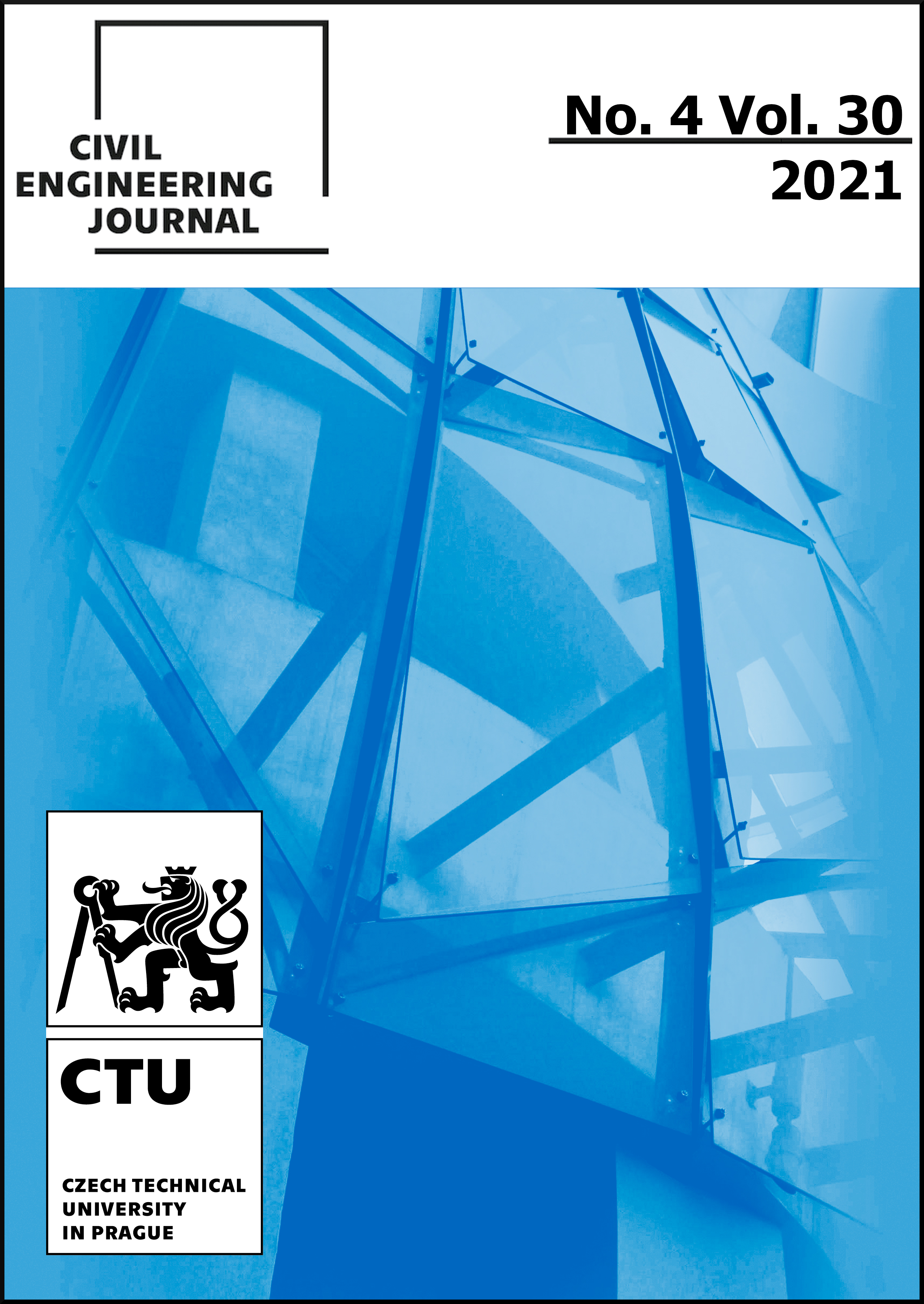THE ROLE OF TECHNICAL AND NATURAL SCIENCES IN STONE MONUMENTS CARE
DOI:
https://doi.org/10.14311/CEJ.2021.04.0070Keywords:
Stone monuments, Tool traces, Weathering, Hyperspectral analysis, PragueAbstract
Stone monuments maintenance requires the systematic approach which should be based on the cooperation among specialist through more branches, especially from humanities, natural and technical sciences. The main aim of this article is to present the benefit of the cooperation among geologists and civil engineers and share preliminary results of the Czech Ministry of Culture project DG20P02OVV021 “Stone surface topography and its application in stone element restoration field”. Historic stone surfaces often contain stonemasons tool traces as an undoubtable part of historical monument value. The study and protection of the testimony of past is therefore very important. As a part of our project, we are conducting field and laboratory research of historic stone surfaces bearing the original tool traces. The studied area is the Prague urban conservation zone for its stone monuments richness from Romanesque to present days. First, the geological research of the stone masonry surface is conducted in the cooperation with archaeologists. The tool traces are documented, and the state of stone is described. Because of the negative influence of weathering processes on the stone durability, respectively tool traces, we decided to monitor the chosen historical stone surface using the hyperspectral analysis. Based on the analysis results we will be able to better understand the behaviour of stone surface and traces on it during the time.
Downloads
References
Březinová D., Bukovanská M., Dudková I., Rybařík V., Praha kamenná, Přírodní kameny v pražských stavbách a uměleckých dílech, Praha, 287 p., 1996.
Goodman R., Introduction to rock mechanics, New York, 562 p., 1989.
R.B.G. Williams, D.A. Robinson, Experimental frost weathering of sandstones by various combinations of salts, Earth Surface Processes and Landforms, 26 (2001) 811-818.
A. Goudie, H. Viles, Salt weathering hazards, John Wiley & Sons Ltd., Chichester, 1997.
WARSCHEID, Th. a J. BRAAMS. Biodeterioration of stone: a review. International Biodeterioration & Biodegradation [online]. 2000, 46(4), 343-368 [cit. 2020-08-18]. ISSN 09648305. Dostupné z: doi:10.1016/S0964-8305(00)00109-8
Biologické napadení stavebních materiálů. Izolace.cz [online]. Praha: A.W.A.L. - PRO, s.r.o., 2006 [cit. 2020-08-18]. Dostupné z: https://www.izolace.cz/clanky/biologicke-napadeni-stavebnich-materialu/
ADAN, Olf a Robert SAMSON. Fundamentals of Mold Growth in Indoor Environments and Strategies for Healthy Living. 1. Wageningen: Wageningen Academic Publishers, 2011. ISBN 978-90-8686-722-6.
CANEVA, Giulia a Salvador ORNELLA. Biodeterioration of Stone. The Deterioration and Conservation of Stone: Notes from the International Venetian Courses on Stone Restoration. 1988, , 182-234.
GRIFFIN, P.S., N. INDICTOR a R.J. KOESTLER. The Biodeterioration of Stone: a Review of Deterioration Mechanisms, Conservation Case Histories, and Treatment. International Biodeterioration [online]. 1991, 28(1), 187-207 [cit. 2020-08-18]. Dostupné z: doi:10.1016/0265-3036(91)90042-P
MARTÍNEZ-MARTÍNEZ, Javier, David BENAVENTE, Miguel GOMEZ-HERAS, Luz MARCO-CASTAñO a M. GARCÍA-DEL-CURA. Non-linear decay of building stones during freeze–thaw weathering processes. Construction and Building Materials [online]. 2013, 38, 443-454 [cit. 2020-08-18]. ISSN 09500618. Dostupné z: doi:10.1016/j.conbuildmat.2012.07.059
MCNAMARA, Christopher a Ralph MITCHELL. Microbial deterioration of historic stone. Frontiers in Ecology and the Environment [online]. 2005, 3(8), 445-451 [cit. 2020-08-18]. ISSN 1540-9295. Dostupné z: doi:10.1890/1540-9295(2005)003[0445:MDOHS]2.0.CO;2
SCHEERER, Stefanie, Otto ORTEGA‐MORALES a Christine GAYLARDE. Chapter 5 Microbial Deterioration of Stone Monuments—An Updated Overview [online]. Elsevier, 2009, , 97-139 [cit. 2020-08-18]. Advances in Applied Microbiology. ISBN 9780123747884. Dostupné z: doi:10.1016/S0065-2164(08)00805-8
SMITH, B.J., M. GOMEZ-HERAS a S. MCCABE. Understanding the decay of stone-built cultural heritage. Progress in Physical Geography: Earth and Environment [online]. 2008, 32(4), 439-461 [cit. 2020-08-18]. ISSN 0309-1333. Dostupné z: doi:10.1177/0309133308098119
WELTON, , RYAN G, Simon CUTHBERT, Roger MCLEAN, Andrew HURSTHOUSE a John HUGES. A Preliminary Study of the Phycological Degradation of Natural Stone Masonry. Environmental Geochemistry and Health. 2003, 25(1), 139-45.
PODLISKA J., SEMERÁD M. Nové poznatky o konstrukci Juditina mostu v Praze. Staletá Praha, 28(2), 2012, dostupné: http://www.staletapraha.cz/media/2012_2/clanky-cele/sp-2-2012-08-podliska-semerad.pdf
Hyperspectral sensors. Headwall Photonics [online]. USA: Headwall Photonics, 2020 [cit. 2020-08-25]. Dostupné z: https://www.headwallphotonics.com/hyperspectral-sensors
HUETE, A.R. a R.D. JACKSON. Soil and atmosphere influences on the spectra of partial canopies. Remote Sensing of Environment [online]. 1988, 25(1), 89-105 [cit. 2021-12-17]. ISSN 00344257. Dostupné z: doi:10.1016/0034-4257(88)90043-0
ENVI Classic. ENVI Classic help [online]. Harris Geospatial Solutions, 2019 [cit. 2021-12-17]. Dostupné z: file:///C:/Program%20Files/Harris/ENVI55/classic/help/ENVI3WHelp.htm#ENVI3WHome.htm%3FTocPath%3DGetting%2520Started%7C_____0
MALENOVSKY Z., TURNBULL JD., LUCIEER A., ROBINSON SA. Antarctic moss stress assessment based on chlorophyll content and leaf density retrieved from imaging spectroscopy data. New phytologist. 2015, 208(2), 608-624, ISSN 0028-646X.
ILLERBRUN K. Antifreeze and sunblock: How mosses survive an Alberta winter, 2021, available online: http://blog.abmi.ca/2021/11/29/antifreeze-and-sunblock-how-mosses-survive-an-alberta-winter/
Downloads
Published
Issue
Section
License
Copyright (c) 2021 Author

This work is licensed under a Creative Commons Attribution-NonCommercial 4.0 International License.
Authors who publish with this journal agree to the following terms:
- Authors retain copyright and grant the journal right of first publication with the work simultaneously licensed under a Creative Commons Attribution License that allows others to share the work with an acknowledgement of the work's authorship and initial publication in this journal.
- Authors are able to enter into separate, additional contractual arrangements for the non-exclusive distribution of the journal's published version of the work (e.g., post it to an institutional repository or publish it in a book), with an acknowledgement of its initial publication in this journal.
- Authors are permitted and encouraged to post their work online (e.g., in institutional repositories or on their website) prior to and during the submission process, as it can lead to productive exchanges, as well as earlier and greater citation of published work (See The Effect of Open Access).
How to Cite
Accepted 2021-12-23
Published 2021-12-31











